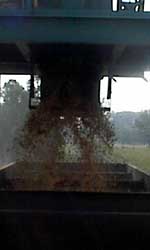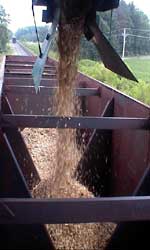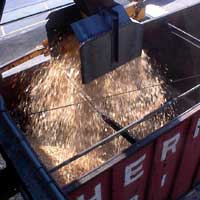Whirley Wizard

Ken Bailey developed this barge-loading device four years ago, and it quickly developed a reputation for sinking barges. At least one barge was "set on the bottom" at each of the first six installations!
Besides distributing chips across the full width of the barge, the chips are caused to lie down like "Pringles" potato chips. Clients using high-buoyancy barges report tonnage increases exceeding 25 percent using this gravity-powered device.


At right is a close-up view of this device. Flow-rates adequate to load a barge in two hours flow through this 48-inch diameter "Whirley Wizard."
Chip mill users report tonnage gains loading rail cars in excess of 25 percent.
Canal Holdings, LLC, owns the patent for this device.
This particular installation does NOT have a belt-scale, so the loading operator simply "guesses" what percentage of the car to load with his Whirley Wizard before topping-off the car via free-fall loading. In the photo at the far right, the operator is intentionally free-fall loading about two-thirds of the car.
According to the mill manager, the all-time heaviest chip car received by a pulp mill from here weighed-in at 18-tons overweight! On another occasion, 11 of 22 cars were set out at a switching yard for being overloaded!

Though quite effective at increasing car-tonnage, the loading dynamics of the Whirley Wizard requires EITHER a reversing-conveyor OR a wide-span pants-leg chute arrangement with a 13-15 foot chute-spacing for loading chip cars. This is NOT feasible in most rail load-out situations.
Shrouding of the Whirley Wizard is necessary to prevent spillage over the car sides. The installation complexity resulting from using this barge-loading device on train cars made it clear that there had to be a better way to achieve additional tonnage when loading chip cars.

